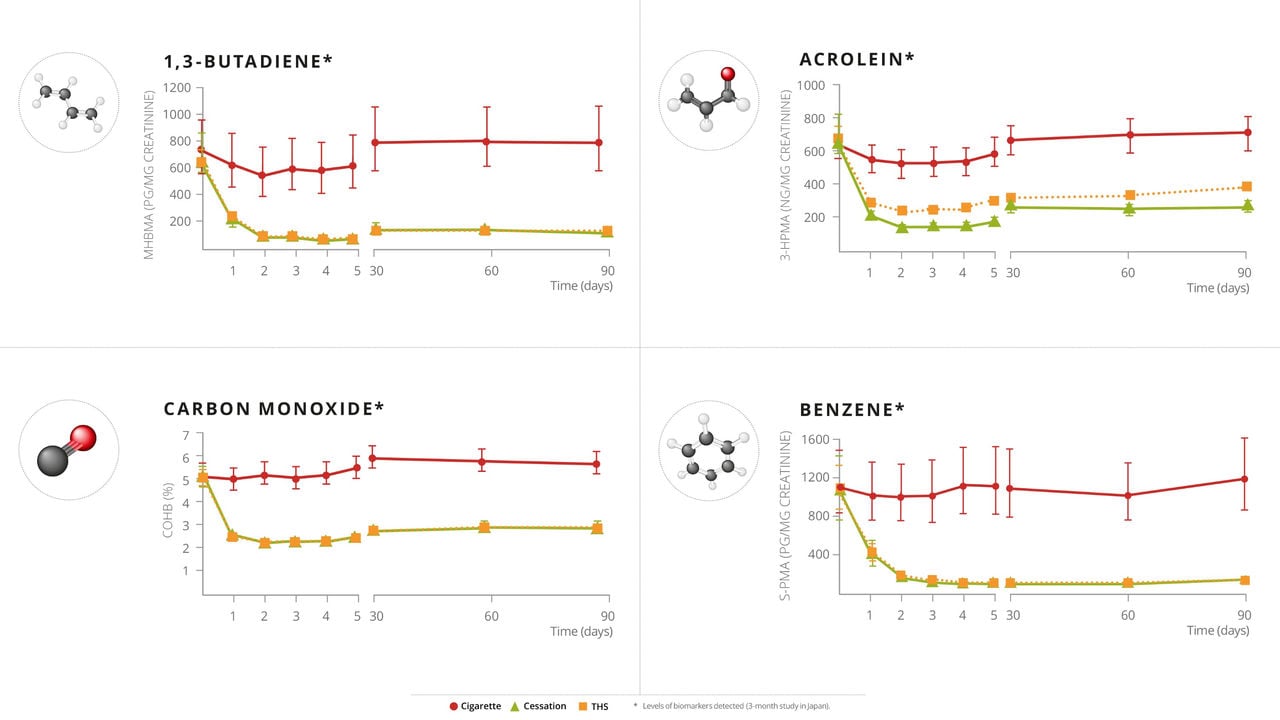Why did cigarette sales decline in Japan?
Tobacco harm reduction
Reducing tobacco-related harm at the population level by introducing less harmful smoke-free alternatives depends not only on the reduction in risk to the individual who switches from cigarettes to the smoke-free product, but also its adoption by adult smokers. According to the harm reduction equation, the more adult smokers who choose the lower-risk options instead of continuing to smoke cigarettes, the bigger the impact on reducing population harm.
HTPs heat the tobacco just enough to release a nicotine-containing aerosol but without burning the tobacco. With HTPs, tobacco is heated and not burned so there is no smoke, and the levels of harmful chemicals in the generated aerosols can be significantly reduced compared with cigarette smoke. Because of this, HTPs have the potential to be less harmful compared with cigarettes. However, this needs to be assessed for each particular product.
The best choice any smoker can make is to quit tobacco and nicotine altogether. But for those adults who would otherwise continue to smoke, the totality of the evidence available today from our rigorous scientific assessment program indicates that switching completely to THS, PMI’s HTP, commercialized as IQOS, while being addictive and not risk free, presents less risk of harm than continued smoking.
Thus, THS has the potential to help adult smokers switch away from combustible cigarettes—the most harmful use of tobacco. In fact, both PMI's and independent studies have explored the relationship between a decline in cigarette sales and the introduction of THS in Japan.
Decline in cigarette sales in Japan after the introduction of THS
THS was introduced in Nagoya, Japan, in late 2014 in a city-wide pilot and rolled out nationwide beginning in 2015. It had a staggered introduction across Japan over this time, producing a detailed set of statistics to analyze.
Following the introduction of THS, cigarette sales began to substantially decline in each of the Japanese regions where it was introduced. Between 2011 and 2015, before the nationwide launch of THS, total tobacco sales in Japan were declining at a rate of 1.8% on average.
Between 2015 and 2023, PMI data showed a substantial overall decline in combusted tobacco sales, with an average annual decrease of 9.5% recorded between 2015 and 2018. This trend continued, reaching a decline in combusted tobacco sales of 92.3 billion sticks in 2023.
Independent studies support the role of THS in declining cigarette sales in Japan
An independent research group published additional data on smoking prevalence in Japan in the British Medical Journal Tobacco Control. They analyzed per capita cigarette sales data from retailers to examine the cause of the decline in cigarette sales. The study covered 11 of Japan’s 12 regions, representing 99% of the country’s population, and 72% of all cigarette sales relative to data reported by Euromonitor International. The data was collected from retail outlets within these 11 regions based on sales data from 2014 to 2018.
In addition to the launch of THS, the authors investigated other potential causes for the decline in cigarette smoking, such as pricing, stricter regulations, the availability of competing HTPs, and even chance. To do so, they applied multiple alternative causation models to the sales figures. The researchers determined that those factors were unlikely to be the main causes of the decline in cigarette sales.
The authors concluded that the introduction of THS was the most likely explanation for the decline in cigarette sales in Japan. However, the authors noted that the study only included sales data and, therefore, could not assess risk or harm reduction.
The authors added, “Definitively identifying that the introduction of a novel tobacco product is significantly changing the marketplace for tobacco products is important information for policymakers and public health proponents as they consider how to alter existing tobacco control policies to accommodate these new products.”
Additionally, an article published by researchers at the Medical University of South Carolina and at the University of Ottawa, explored the relationship between the decline in cigarette sales in Japan between 2011 and 2019 and the introduction of HTPs into the Japanese market in late 2015. Data for this study came from the Tobacco Institute of Japan and publicly available data from PMI.
This study found that the acceleration in the decline in cigarette sales in Japan since 2016 does, in fact, correspond to the 2015 introduction of THS and the growth in sales of HTPs in the country. Between 2011 and 2019, the study found that overall cigarette sales fell by 38% and total tobacco sales declined by 19%. Following the introduction of HTPs into the Japanese market between 2016 and 2019, the annual percent change (APC) for tobacco sales overall between 2011 and 2019 was -4.77% (a negative APC indicates that the sales dropped over time). However, separating out cigarette-only sales from HTP sales revealed a different pattern. The APC for cigarette-only sales was -3.10% between 2011 and 2015, and -16.38 % between 2016 and 2019, showing a significantly increased decline in cigarette sales following the introduction of HTPs.
The authors noted that their work did not address whether cigarette smokers were completely substituting one product for another, just that the data indicates that HTPs have accelerated the decline in cigarette sales.
Supporting these conclusions is data from the 2022 Japanese National Health and Nutritional Survey (NHNS), an annual nationwide health examination survey conducted in Japan since 1948 under the Japanese Ministry of Health, Labour and Welfare. Published in 2024, this found that the ongoing decline in tobacco product usage and smoking prevalence in Japan is continuing, showing a reduction from 16.7% of the total population in 2019 to 14.8% in 2022.
Data from the 2022 NHNS also indicates that adoption of HTPs has not increased the overall tobacco product consumption, suggesting a transition among existing tobacco users to HTPs, rather than an uptake of HTPs in addition to cigarettes. Dual use rates are also low in Japan, representing just 13% of all heated tobacco users and 0.6% of all adults in Japan.
PMI’s studies of tobacco use in Japan
Since 2016, PMI has conducted repeated cross-sectional studies of tobacco use prevalence in Japan, assessing tobacco use behaviors and prevalence among a representative sample of the adult population. These comprehensive studies aimed to capture the dynamic landscape of tobacco consumption, with a sample size ranging from 4,000 to 7,000 adults annually.
The findings from these repeated cross-sectional studies indicate a steady decline in overall tobacco use prevalence, reflecting trends consistent with the NHNS data. From an initial prevalence rate of 18.5% in 2016, overall tobacco and nicotine product use decreased to 15.4% in 2023. Notably, there was a significant reduction in cigarette smoking, from 17.6% to 11.8%, during the same period. Conversely, the use of HTPs increased from 1.9% to 5.2%, demonstrating that HTPs are effectively replacing conventional cigarettes in Japan.
This data corroborates the findings from the NHNS, highlighting the pivotal role of HTP adoption by adult smokers in reducing cigarette prevalence and the ongoing shift towards smoke-free alternatives. PMI’s study design also aligns closely with the methodology of the NHNS.
In addition to the Japanese study, PMI has conducted similar cross-sectional studies in Germany and Italy. For more information, see:

Read the Scientific Update magazine
The Scientific Update magazine is focused on PMI's research and development efforts, milestone studies, industry regulations, and more. View the latest issue, or read the articles online.


